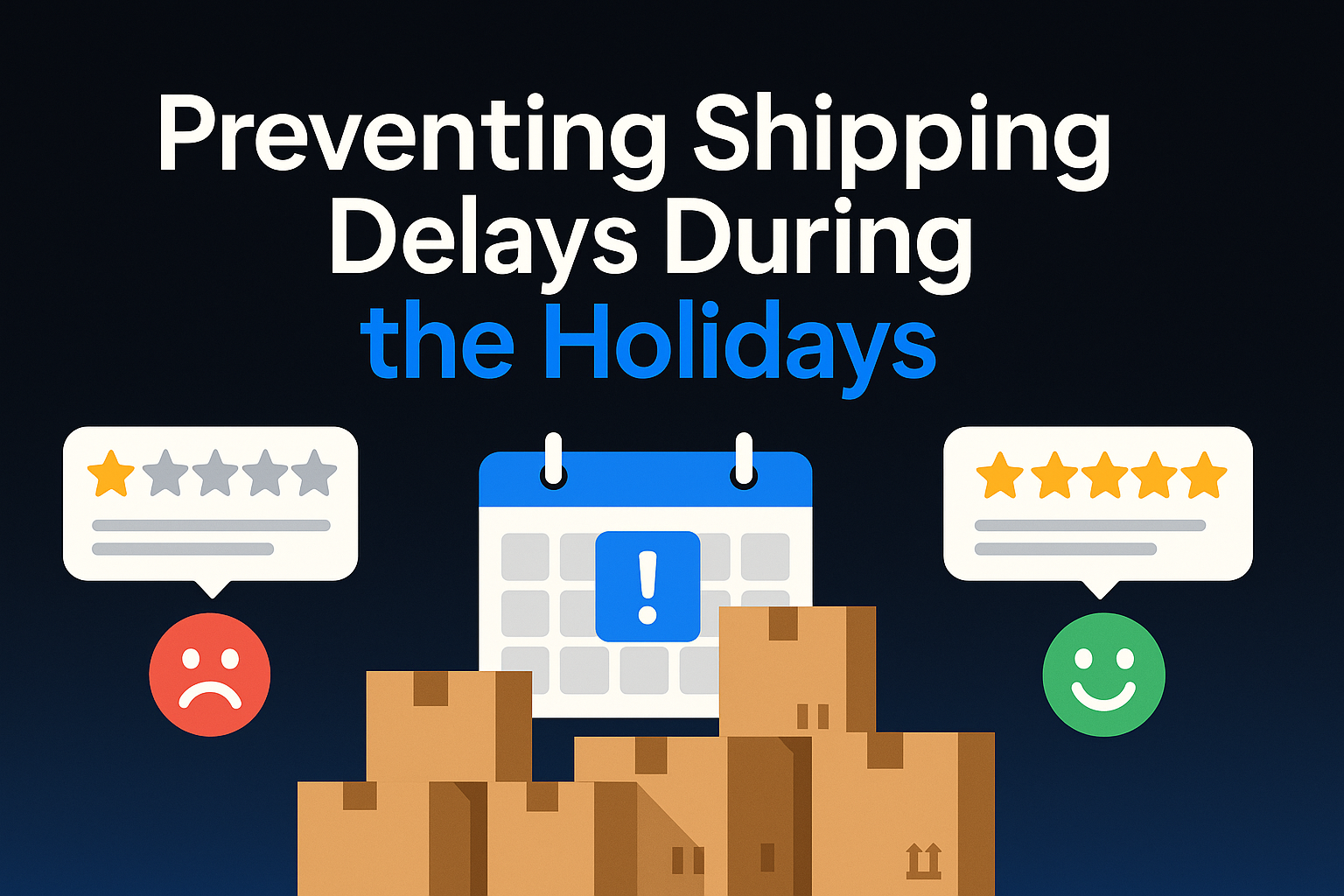Mastering Holiday Logistics: Preventing Shipping Disruptions in Your E-commerce Business
The holiday shopping season represents both a tremendous opportunity and a significant challenge for e-commerce businesses. As order volumes surge during these peak periods, maintaining efficient and reliable delivery timelines becomes increasingly difficult. Yet the fulfillment experience often determines whether customers return to your store in the future.
Research shows that shipping performance during high-volume periods has a disproportionate impact on customer perception, with delivery experiences during the holiday season influencing purchasing decisions throughout the following year. In this guide, we'll explore comprehensive strategies to prevent shipping disruptions during the busiest retail periods.

The Business Impact of Delivery Disruptions
Before addressing prevention strategies, it's important to understand exactly what's at stake when shipping delays occur during peak seasons.
Long-term Customer Value Erosion
The most significant impact of shipping delays extends far beyond the immediate transaction. Data from multiple studies reveals that delivery experiences substantially influence customer lifetime value:
- 73% of shoppers state they are unlikely to purchase from a retailer again after a poor delivery experience
- 87% of consumers who experience on-time delivery during peak seasons demonstrate higher loyalty rates in subsequent quarters
- First-time holiday shoppers who receive orders on schedule have a 64% higher probability of becoming repeat customers
These statistics demonstrate that reliable shipping isn't merely about satisfying immediate customer expectations—it's about protecting future revenue streams by preserving customer relationships.
Brand Perception and Social Amplification
In today's connected environment, shipping disruptions rarely remain private matters between merchant and customer:
- The average dissatisfied customer tells 9-15 people about their negative experience
- 34% of customers who experience delivery delays share their frustration on social media
- Negative shipping reviews are 21% more likely to be shared than positive ones
This amplification effect means that each shipping delay potentially influences dozens of future purchasing decisions beyond the affected customer.
Financial Implications Beyond Lost Sales
The financial impact of shipping disruptions extends beyond lost future sales:
- Customer service costs increase by 32% during periods with significant shipping delays
- Return rates for delayed holiday shipments are 24% higher than on-time deliveries
- Refund and reshipment expenses can reduce holiday season profitability by up to 11%
These combined effects mean that preventing shipping disruptions represents one of the highest-ROI activities for e-commerce businesses during peak seasons.
Common Causes of Holiday Shipping Disruptions
Understanding the typical causes of delays during high-volume periods is essential for effective prevention. These challenges fall into several categories:
Capacity Limitations
- Carrier Network Congestion: Shipping carriers experience volume increases of 30-40% during peak seasons
- Warehouse Processing Bottlenecks: Order fulfillment capacity often can't scale as quickly as incoming order volume
- Staff Limitations: Seasonal hiring challenges can leave fulfillment operations understaffed during critical periods
Environmental and Seasonal Factors
- Weather Disruptions: Winter shipping conditions create delays in approximately 23% of holiday deliveries
- Geographic Bottlenecks: Certain shipping lanes experience disproportionate congestion during peak periods
- International Shipping Complexities: Cross-border shipments face additional inspection and clearance delays during high-volume periods
Internal Operational Challenges
- Inventory Management Issues: Stock accuracy typically decreases by 8-12% during high-volume periods
- Communication Breakdowns: Information gaps between sales, fulfillment, and shipping departments increase during busy periods
- Technology Integration Failures: System overloads can disrupt the flow of order information to fulfillment systems
Proactive Strategies to Prevent Holiday Shipping Disruptions
The most effective approach to holiday shipping management involves implementing preventive measures well before the peak season begins. Here are comprehensive strategies to protect your delivery performance:
1. Develop a Seasonal Logistics Strategy
Start planning for peak shipping periods at least 90 days in advance with these key components:
Carrier Diversification and Redundancy
Relying on a single shipping carrier during high-volume periods creates significant vulnerability. Implement these practices:
- Establish relationships with multiple carriers with overlapping service areas
- Allocate volume across carriers based on their performance in specific regions
- Implement automated carrier selection tools that route packages based on real-time performance
Transparent Delivery Timeline Management
Customer dissatisfaction often stems from unmet expectations rather than actual delivery speed:
- Adjust displayed shipping timelines to reflect realistic holiday delivery windows
- Implement dynamic delivery date calculations that account for carrier capacity and regional factors
- Over-communicate potential delays with pre-purchase notifications
Early Bird Incentive Programs
Redistribute shipping volume away from the most congested periods:
- Create promotional campaigns that incentivize early holiday shopping
- Implement graduated shipping rates that reward customers who order early
- Develop "guaranteed by" shipping options for specific holiday dates with appropriate cutoffs
2. Optimize Your Fulfillment Infrastructure
The foundation of reliable shipping starts with your internal fulfillment operations:
Inventory Positioning and Distribution
Strategic inventory placement can significantly reduce transit times and vulnerability to regional disruptions:
- Implement inventory forecasting models that account for seasonal demand patterns
- Distribute inventory across multiple fulfillment locations based on regional ordering patterns
- Consider temporary fulfillment partnerships in strategic locations during peak periods
Workforce Planning and Training
Human resources represent both the greatest asset and potential constraint in holiday fulfillment:
- Begin seasonal hiring at least 45 days before anticipated volume increases
- Implement comprehensive training programs focused on high-volume operations
- Cross-train existing staff to provide flexibility during peak periods
- Consider shift scheduling approaches that maximize throughput during optimal shipping windows
Technology Infrastructure Assessment
Technical limitations often become apparent only under peak load:
- Conduct stress testing of order management systems at least 60 days before expected volume peaks
- Implement redundancies for critical fulfillment technology components
- Ensure integration points between shopping carts, inventory systems, and shipping platforms can handle increased transaction volume
3. Implement Advanced Shipping Workflows
Beyond basic preparation, consider these sophisticated approaches to holiday shipping management:
Batch Processing Optimization
Improve fulfillment efficiency through strategic order grouping:
- Implement wave picking processes that maximize productivity during peak periods
- Group orders by shipping carrier to streamline pickup and processing
- Prioritize processing based on delivery promise dates rather than order chronology
Predictive Analytics Integration
Use data to anticipate and prevent potential disruptions:
- Implement tracking anomaly detection to identify shipments at risk of delay
- Utilize carrier performance data to adjust routing decisions in real-time
- Apply machine learning models to predict and mitigate potential fulfillment bottlenecks
Automated Exception Management
Develop systems to rapidly identify and address emerging shipping issues:
- Implement automated escalation procedures for at-risk shipments
- Create proactive notification systems for potential delays
- Develop standardized mitigation workflows for common shipping disruptions
Responding Effectively When Delays Occur
Despite best efforts, some shipping disruptions are inevitable during peak periods. How you respond to these situations significantly impacts customer satisfaction and retention.
1. Proactive Communication Protocols
Customers consistently report that proactive communication about delays significantly reduces dissatisfaction:
- Implement automated delay detection and notification systems
- Communicate issues before customers need to inquire about order status
- Provide specific information rather than generic delay messages
- Offer visibility into resolution efforts and revised delivery timelines
2. Strategic Recovery Options
When delays occur, have predefined response strategies ready to implement:
Tiered Compensation Framework
Develop a structured approach to making customers whole:
- Create a standardized compensation matrix based on delay severity and customer value
- Consider options beyond refunds, such as loyalty points or future purchase credits
- Empower customer service teams with appropriate recovery authorization levels
Expedited Resolution Pathways
Establish procedures to accelerate delivery of delayed orders:
- Maintain relationships with premium shipping services for critical recovery situations
- Consider local delivery partnerships for urgent situations in key markets
- Develop processes for in-store pickup options when available
Long-term Relationship Recovery
Focus on rebuilding trust after shipping disruptions:
- Implement post-resolution follow-up communications
- Provide "make good" offers on future purchases
- Create segmented remarketing campaigns for affected customers
Case Study: E-commerce Retailer's Holiday Shipping Transformation
A specialty retailer struggling with holiday shipping performance implemented the following changes:
- Diversified their carrier strategy from one primary carrier to three balanced partners
- Adjusted displayed delivery dates to add 2-3 days to standard estimates during peak periods
- Implemented early shopping incentives that shifted 22% of holiday volume to earlier weeks
- Deployed regional inventory positioning in three strategic locations
- Developed automated exception management for at-risk shipments
Results:
- On-time delivery rates improved from 74% to 94% during peak season
- Customer service contacts regarding shipping decreased by 61%
- Return rates declined by 18% compared to previous holiday season
- Customer retention increased by 23% for holiday shoppers
Mobile App Advantage in Holiday Shipping Management
E-commerce businesses with dedicated mobile apps have a significant advantage in managing holiday shipping experiences. Mobile apps provide unique capabilities for optimizing the delivery experience:
1. Enhanced Order Tracking Integration
Mobile apps enable superior order tracking experiences:
- Push notifications for shipment status changes
- Interactive maps with live package tracking
- Barcode scanning for easy tracking lookup
2. Streamlined Communication Channels
Direct communication improves delay management:
- In-app messaging for shipping updates
- Integrated customer service access
- Personalized shipping alert preferences
3. Flexible Delivery Management
Mobile interfaces enable convenient delivery adjustments:
- Delivery timing modification options
- Address change capabilities
- In-app delivery instructions
Taptool's mobile app platform makes implementing these shipping management features straightforward, with pre-built components for order tracking, communication, and delivery management.
Conclusion: A Strategic Approach to Holiday Shipping
While holiday shipping challenges are inevitable in e-commerce, their business impact is not. By implementing comprehensive prevention strategies, developing effective response protocols, and leveraging technology appropriately, online retailers can transform potential disruptions into opportunities to demonstrate reliability and build customer loyalty.
The most successful e-commerce businesses view holiday shipping not as a logistical challenge to be managed, but as a strategic opportunity to differentiate their customer experience during critical purchasing periods.
By planning thoroughly, communicating transparently, and responding effectively, you can ensure that your fulfillment operation becomes a competitive advantage rather than a vulnerability during the most important retail season of the year.
To learn more about optimizing your mobile app experience for holiday shopping seasons, visit our App Design Guide.
